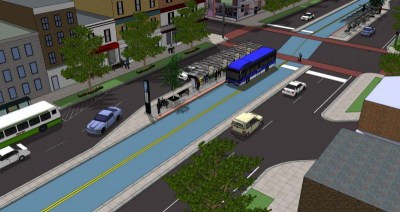Are American Cities Building Top-Notch BRT or “Light Rail Lite”?

NYC’s Select Bus Service shaves trip time appreciably, but doesn’t yet fit the definition of a world-class BRT system.
What makes a bus system "rapid"? Trying to agree on an answer can get contentious. With a big menu of possible features for transit operators to choose from — pre-payment, priority signal timing, and physically separated lanes, to name a few — the quality of systems labeled "Bus Rapid Transit" varies widely. Some live up to expectations for "surface subways" and some don’t.
Over at the City Fix, Dario Hidalgo notes the problems that arise from the inconsistency:
More than just semantics, this confused nomenclature can lead to
real-world policy problems, diluting the concept of BRT and
undercutting efforts to promote it with skeptical populaces and
politicians.
To set things straight, Hidalgo recommends a term coined by Allan Hoffman and Alasdair Cain in a recent article in Mass Transit Magazine: "Quickways." Here’s the quick and dirty version of how they distinguish Quickways from other forms of BRT:
A Quickway, by definition, is a specialized bus guideway
incorporating a number of essential elements.It is fully segregated from automobile and pedestrian traffic; neither cars nor people cross its path nor do private automobiles operate along the right-of-way. The geometries support high-speed operations between stations. Stations are equipped with passing lanes, so that express vehicles can continue through without needing to stop.
Hoffman and Cain’s piece is well worth the read. The Quickway model, they point out, has yet to take hold in American cities, where the prevailing type of BRT is what they call "Light Rail Lite." Whereas cities like Bogotá and Brisbane have invested in complete BRT networks with an eye toward achieving ambitious ridership targets, the "Light Rail Lite" model looks to improve service along individual corridors at minimal cost.
Not every ingredient proposed by Hoffman and Cain may be feasible — or desirable — for American cities, but the authors believe that aiming for the Quickway ideal can help deliver the mode switch and sustainable land use patterns which full-fledged BRT enables:
Quickways are not merely a graduated step-up in BRT-supportive
infrastructure; they imply their own logic on system design and
operations and make possible services that otherwise would not be
cost-justifiable. They mesh well with other modes and create far more
useful transit networks, extending systemwide benefits beyond
individual corridors. They can create economies of scale for transit
operations, virtuous circles that can support wider-reaching mobility
goals, economic development, and sustainable urban form. They should be
treated as a distinct mode, particularly for network and corridor-level
planning, and one with great potential for helping American cities
achieve phase shifts in the role that transit plays in their daily
lives and long-range growth.
Photo: Kriston/Picasa Web
